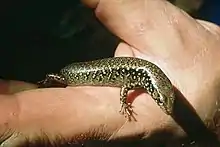Whitaker's skink
Whitaker's skink (Oligosoma whitakeri),[3] also known commonly as Whitaker's New Zealand skink,[1][2] is an endangered[1] species of skink, a lizard in the family Scincidae. The species is found only in New Zealand.
| Whitaker's skink | |
|---|---|
 | |
| Scientific classification | |
| Kingdom: | Animalia |
| Phylum: | Chordata |
| Class: | Reptilia |
| Order: | Squamata |
| Family: | Scincidae |
| Genus: | Oligosoma |
| Species: | O. whitakeri |
| Binomial name | |
| Oligosoma whitakeri (Hardy, 1977) | |
| Synonyms[2] | |
| |
Etymology
The specific epithet, whitakeri, is in honour of Anthony Whitaker, a New Zealand herpetologist who studied New Zealand lizards for more than 30 years.[4][5]
Habitat and behaviour
Whitaker's skink lives in coastal forest and scrub. During the day it retreats to warm, moist places such as seabird burrows and deep boulder banks, and emerges on warm humid nights to forage.
Geographic range
O. whitakeri is found on two small, predator-free islands off the Coromandel Peninsula – Middle Island in the Mercury Islands group, and Castle Island. There is also a mainland population in a small rocky area at the base of coastal hills at Pukerua Bay, near Wellington. Fossil bones found in the Waikato region suggest that these skinks were once more widely distributed.[6] The New Zealand Department of Conservation and the Friends of Mana Island are running a five-year project to catch and breed enough animals from the vulnerable Pukerua Bay colony to establish a sustainable population on nearby predator-free Mana Island.
Conservation status
As of 2012 the Department of Conservation (DOC) classified Whitaker's skink as Nationally Endangered under the New Zealand Threat Classification System.[7]
References
- Lettink M, Hitchmough R, van Winkel D, Chapple D (2019). "Oligosoma whitakeri ". The IUCN Red List of Threatened Species 2019: e.T6013A120190515. https://dx.doi.org/10.2305/IUCN.UK.2019-2.RLTS.T6013A120190515.en Downloaded on 25 December 2020.
- Uetz P, Freed P, Hošek J (eds.). "Oligosoma whitakeri ". The Reptile Database. Retrieved 2017-11-21.
- Chapple, David G.; Ritchie, Peter A.; Daugherty, Charles H. (2009). "Origin, diversification, and systematics of the New Zealand skink fauna (Reptilia: Scincidae)". Molecular Phylogenetics and Evolution. 52 (2): 470. doi:10.1016/j.ympev.2009.03.021. PMID 19345273.
- Gill, Brian; Whitaker, Anthony (1996). New Zealand Frogs & Reptiles. Auckland, New Zealand: D. Bateman. ISBN 978-1-86953-264-2.
- Beolens, Bo; Watkins, Michael; Grayson, Michael (2011). The Eponym Dictionary of Reptiles. Baltimore: Johns Hopkins University Press. xiii + 296 pp. ISBN 978-1-4214-0135-5. (Cyclodina whitakeri, p. 284).
- Wilson, Kerry-Jayne. "Lizards - Conservation". Te Ara - the Encyclopedia of New Zealand. Retrieved 2014-12-27.
- Hitchmough, Rod; Anderson, Peter; Barr, Ben; Monks, Jo; Lettink, Marieke; Reardon, James; Tocher, Mandy; Whitaker, Tony. "Conservation status of New Zealand reptiles, 2012" (PDF). Department of Conservation. The Government of New Zealand. Retrieved 18 July 2015.
External links
Further reading
- Hardy GS (1977). "The New Zealand Scincidae (Reptilia: Lacertilia); a taxonomic and zoogeographic study". New Zealand Journal of Zoology 4: 221–325. (Cyclodina whitakeri, new species, pp. 269–270).
